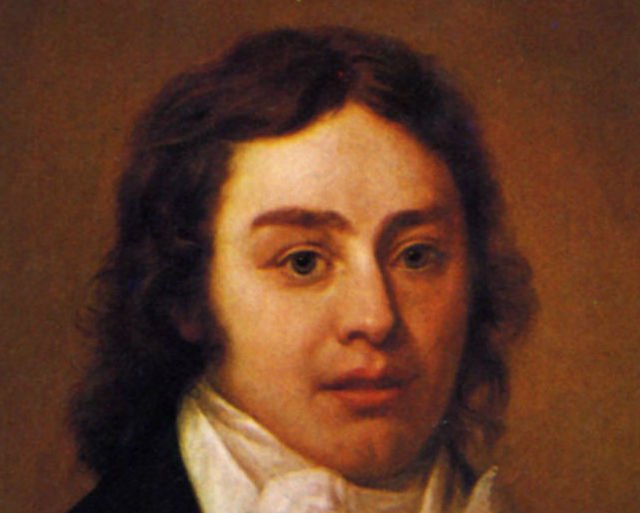Famous people
Samuel Taylor Coleridge
Variously described as poet, philosopher, journalist, literary critic, psychologist, fell walker, travel writer, naturalist, translator and letter writer, Samuel Taylor Coleridge was born at Ottery St. Mary 21st October 1772. He was christened in the church on 30th December 1772 and named after his godfather, Mr. Samuel Taylor. Samuel’s parents were John and Ann Coleridge, and John was vicar of St. Mary’s Church as well as The Master of The King’s School. Samuel was the tenth and youngest child of the family.
As a boy, Samuel was precocious and highly strung: at the age of 6, he was already an obsessive reader. Samuel’s later religious and romantic outlook on life, his love of “the Great” and “the Whole”, and his opposition to purely rational explanation, all have origins in his childhood experiences in Ottery St. Mary.
Central to those experiences, must have been St. Mary’s Church. Samuel once described how “I used to lie by the wall and mope, and my spirits used to come upon me sudden and in a flood; and I then was accustomed to run up and down the churchyard and act over again all I had been reading, to the docks and the nettles and the rank grass… became a dreamer.” Nearby, there was the River Otter and Pixies Parlour (a sandstone cave inhabited by all kinds of “invisible creatures”). It is not difficult to imagine the formative influences of these surroundings on the brilliant mind of the young Samuel Taylor Coleridge.
Samuel grew up to become one of the greatest intellectual forces of his time. In the area of Christianity, he wrote how its proof lay not in assenting to it but rather, in living it. He said, “Christianity is not a Theory, or a Speculation, but a Life; not a Philosophy of Life, but a Life and a living Process”. He died on Friday 25th July 1834 at No.3 The Grove, Highgate and is buried in St. Michael’s Church, Highgate.

John Coleridge Patteson
John Coleridge Patteson was not born in Devon, but in Gower St. in London on 1st April 1827; his father was a high court judge, his mother the niece of the poet Samuel Taylor Coleridge. Because he had relatives in Devon, “Coley”, as he was always called, was sent at the age of eight to be a boarder at The King’s School in Ottery, where he spent three years, before going on to Eton, then to Balliol, Oxford.
In 1854 Patteson was made a deacon and travelled back to Devon to take up his role as curate at Alfington. But in March 1855 he set sail with Bishop Welwyn for the other side of the world first to New Zealand and then to the Solomon Islands. Way ahead of their time, both felt that it was important for the church to be led by its own people; it was Patteson’s job to train them, which he loved – and managed to learn over 20 of their languages.
Selwyn decided the islands should have their own Bishop, and in 1861 Patteson became the first Bishop of Melanesia. It was not an easy calling: the islands were scattered over 1,800 miles of ocean, and he was not always welcomed. Patteson’s task was to be made even harder when traders from Australia began to visit the islands, keen to get men to go and work on their sugar plantations. Usually they kept the law and agreed proper terms of employment: but some simply kidnapped the islanders and carried them off in what became known as “snatch-snatch” boats. The relatives would be so angry and upset they would vow to take revenge on any white person. Unfortunately Patteson was mistaken for a “snatcher” and was killed in August 1871. Bishop Patteson’s death shocked the British government into taking measures to stamp out the slave trade in its Pacific territories. Gradually the Melanesian islands began to lose their reputation for violence as the people learned a new faith and a new way of living.

Sir Ernest Mason Satow
Ernest Satow was a British diplomat, scholar and Japanologist, and better known in Japan than here in the UK, despite being a key figure in Anglo Japanese relations in the late 19th and early 20th centuries.
Satow’s rise in the consular service was due initially to his competence as an interpreter at a time when English was virtually unknown in Japan. He was promoted to full Interpreter and then Japanese Secretary to the British legation, and, as early as 1864, he started to write translations and newspaper articles on subjects relating to Japan.
He served also in China, Uruguay and Morocco being promoted to the Diplomatic services (which was very rare for someone not born into the aristocracy).
In his retirement in Ottery he wrote A Guide to Diplomatic Practice, now known as ‘Satow’s Guide to Diplomatic Practice’ which is still in use today.
He died on 26 August 1929 at Ottery St Mary, and is buried in St Mary’s churchyard.

Famous events
Ordination Firsts
On 26 September 2015, St Mary’s was the location of the first ordination of a woman priest (in fact, two) by a woman bishop Sarah Mullally, Bishop of Crediton.


